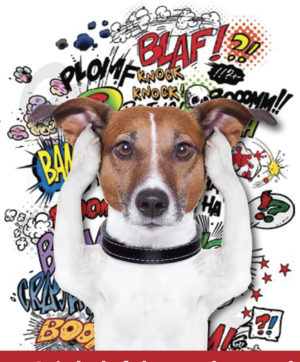BOOM – BANG – CLANG – CRASH – a clap of thunder or fireworks and our pets do the great disappearing and vanishing act. Some hide under beds, some cower in corners. Other common behaviors include panting, pacing and circling, excessive barking or whining, trembling, destructive behaviors, hiding or escaping, and sometimes inappropriate urinating and/or defecating.
 It is helpful to understand how loud noises affect our furry friends.
It is helpful to understand how loud noises affect our furry friends.
We live in a noisy world! We, however, have learned to identify the noises in our environment and most of the times do not respond in fear – they’ve just become “white noise” in the background. Imagine though if you were bombarded with noises that you couldn’t identify? Dogs and cats do not know the source of the noises or if they’re safe or harmful. Dogs and cats hear at higher frequencies and greater distances than humans and what protected them in the “wild” can now be a source of great anxiety and stress. It is important to realize that the behaviors are a result of our pets trying to cope and deal with the stress caused by loud unknown noises.
Anxiety and stress are not healthy for people or pets – it is important to do what we can to keep our pet’s anxiety levels low. Unfortunately our pet’s fearful behaviors often “generalize” and they start to react to every sudden or loud noise the same way as they do to thunder or fireworks. A large percentage of dogs with noise anxiety also develop other panic disorders such as separation anxiety.
A general pet behavior principle is to reward desired behaviors rather than reinforcing undesirable behaviors. This is especially important when dealing with noise anxiety. In our attempts to soothe and comfort our pets we sometimes add to their stress and reinforce their anxious behaviors. Instead we should try to act normally as if we don’t notice their fearfulness. Dogs and cats are very intuitive and will pick up on our anxiety. They can’t distinguish between our concerns for them and being scared for ourselves. They understand more from our actions than our words. Being calm around our anxious pets helps them remain calm.
Redirecting or distracting your pet is one way to help them especially when they are just beginning to get anxious. Encouraging engagement in their favorite activity distracts them from behaving fearfully. Playing ball or fetch with them and rewarding them for paying attention helps associate the noise with “good things”. However, as soon as the fearful behaviors start we need to stop the process. Otherwise we start rewarding the fearful behaviors.
The next best way to help your pet is to create a safe place for them. Try to locate a place that is noise-proof and provides a sense of safety. Consider providing buffering “white noise” by adding a fan, radio or TV to block out the scary sounds. Adding a bed and stress-release toys will add to their sense of safety and helps create a place they associate with safe things rather than frightening things. Chewing for dogs is a great stress-reliever and providing bones and chewy toys will help them. Cats tend to just hide in safe places and usually skip the distracting stage but providing stress-reducing toys such as scratchers placed in various areas will help them relieve their stress.
If your pet exhibits signs of noise anxiety that seem to be getting worse or are already severe consult with your veterinarian or an animal-behavior specialist to design a program to help your pet deal with their anxiety issues. ©LVPSM
